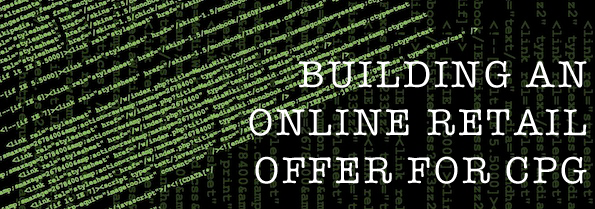I’ve blogged a few times about the increasingly urgent need to develop an online retail offer but I’ve yet to give clear guidance as to what CPG manufacturers should be doing. Let me be clear in this, I have no doubt that leading manufacturers are already thinking hard about this but my perception is that most of this thinking is being done in global and regional offices far from the action. So here is my view of what should be done to address the opportunities and threats that the inevitable growth of online sales present
1. Get serious about this now – I’ve said this before but the potential for online sales to rise dramatically and exponentially exists globally – in both developed and emerging markets. There is a potential for online to take between 15% and 20% of sales of sales in the medium-term (IGD Report). If you wait for this to happen there are some nasty surprises in store. As retailers lose the advantage of location, and as sales slip from in-store to online, they will compete ferociously to sustain margins and price points. This is already happening in China and elsewhere and it’s likely to put manufacturers under extreme margin pressure. Anticipate this in your-medium term plans and gear up for wholesale changes in the retail landscape.
2. Anticipate shopper behavior – practically speaking and in the short-term, online sales are most likely to come from the younger, more time-poor segments of the population. If your brands depend on young singles and new families, it’s these segments whose attitudes and propensity to shop online you need to understand now. It will be important to understand how many people will shop online and what would motivate them to or prevent them for doing so. Quantify this so that you can estimate the potential flow of volume that you can expect under different scenarios.
3. Anticipate the needs of an online channel – online retailers don’t need to worry about availability in multiple stores – what’s key is availability in their warehouse at the point of demand. This will require a responsive demand planning and replenishment approach that works in tune with e-tailers’ forecasting and fulfillment systems. Online retailers will be much less forgiving as they seek to hold optimum inventory levels. Online retailers will need to know more about the people consuming and buying your products so that they can make fast judgments about which segments to prioritize and how to increase basket size
4. Develop an understanding of how shoppers buy online – Today many online grocery retailers mostly catalogue alphabetically (which means shoppers see products that begin with A first). If your brand begins with C, D, P or O – you won’t be seen first. This means that Aquafresh will probably outperform Colgate online, especially when Aquafresh offers the first three SKUs half price as they do today on Tesco’s mobile app. Shoppers will need to change: today they are used to navigating in-store environments by using brand cues like colors, fonts and block merchandising. This doesn’t happen online – shoppers will have to find products in a completely different environment. Manufacturers have to lead in providing insight into how to get the most from a category online – otherwise the retailer will make up their own mind.
5. Plan where to invest and what to invest in – the structures of trade investment are about to change – the price of a home page Ad. could well become the largest investment companies make in the future, the cost of leading shoppers through search processes, creating curated product recommendations and personalizing offers will be high. In a world where the retailer can stock any brand, slotting fees could well become a thing of the past. But so could the notion of credit terms – in the same way that Amazon can print books on demand, online grocery stores can order to demand making payment on sale a logical way to avoid the cost of holding inventory.
6. Organize for change – things are going to be different and radically so. In an environment where a consumer can be sitting at home playing on Facebook or watching a video could spontaneously become a shopper, the concepts of above-the-line and below-the-line advertising are going to merge rapidly. Key account and trade marketing teams will need new skills and technology to support them. New jobs will be invented, for which, the rules have yet to be written so recruitment will be tough. Find committed intelligent individuals who ‘get’ the idea of buying online and can leverage technology to manage complexity
I believe things are going to change radically and quickly and I’m pretty certain that some readers might think all this is a bit over-blown so here’s a few thoughts to consider: Let’s say I’m right and online takes off rapidly – if you act now, you get to benefit from being a leader in the space and not being a follower, you get to capitalize on a brand new channel for selling your goods. If I’m wrong and shoppers are slow to adopt online and sales are insignificant – taking the actions I’ve suggested above still make you more responsive to the market and more competitive as a result. The worst case scenario is that I’m right and you don’t act – consider the costs of catching up in a market that has already changed where competitors are ahead and where your brands have suddenly become invisible.
